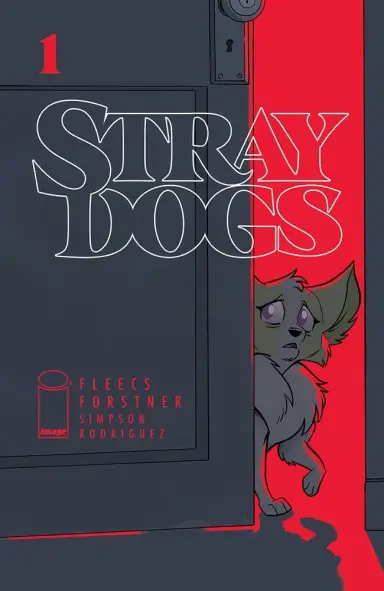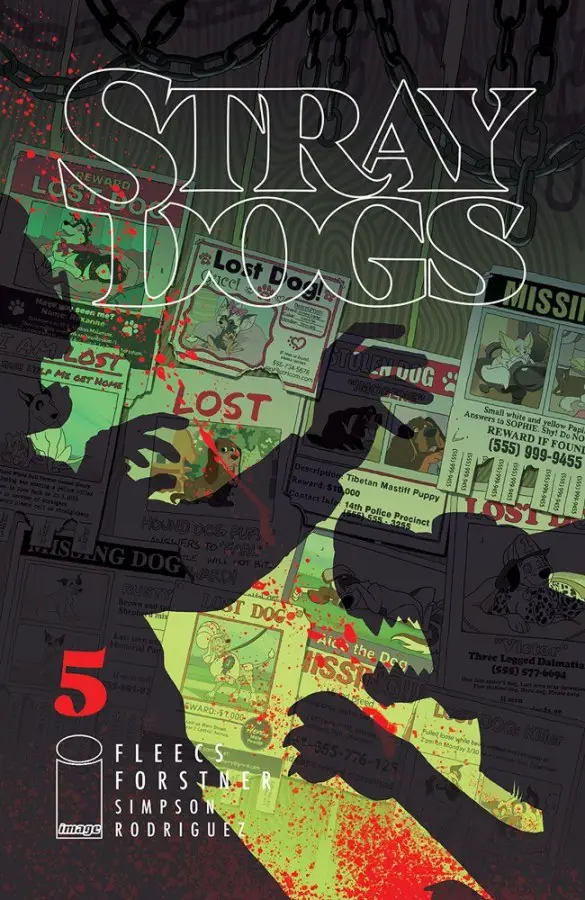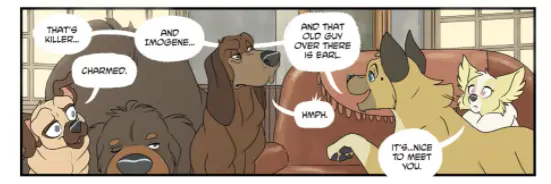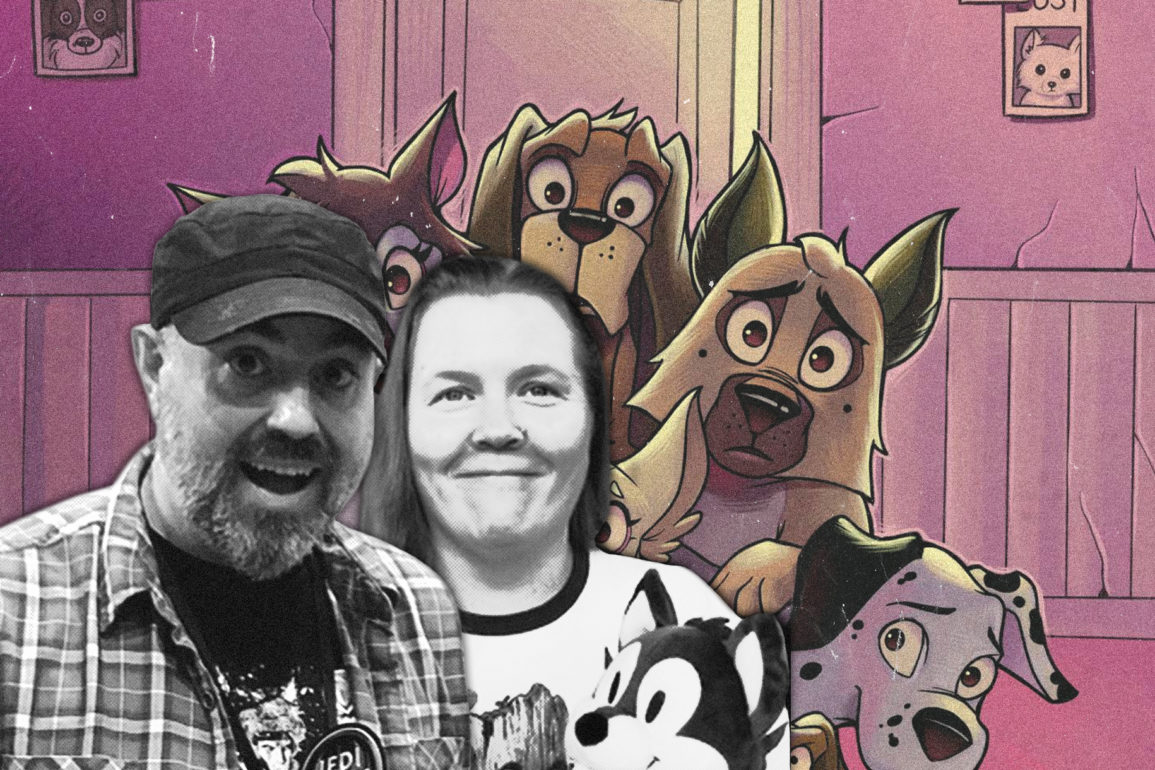Answers have been slightly edited for clarity and content.
Can you tell me about the conception of Stray Dogs? How did Stray Dogs start and what has the journey been like getting to this point?
Tony Fleecs: Well, I was watching a show and there was a serial killer in the show. When I walked out of the room he didn’t have a dog and when I came back he had a dog with him, and I was like, “Oh, did he kill somebody and take their dog as a trophy?” My friends were in the room and they were like, “No, he didn’t kill anybody and take their dog.” And I was like, “That would be cool if he did though.”
I started tumbling it around in my head then. Soon after, that’s when I asked Trish if she wanted to be involved. I started thinking about who could draw it perfectly, like who could capture that ’90s animated style perfectly. And I saw this picture that Trish had done online of one of her dogs, and it was this All Dogs Go To Heaven style, and I just loved it so much. So, I asked her about it at a Brony Convention in Baltimore like three years ago now. She was on board right away, right?
Trish Forstner: Yeah, yep! I mean, the pitch came through and once I picked my jaw up off the floor, I was like, “Yeah I’m in, sign me up!”
Going into the comics themselves, having the perspective be from a dog is sort of the initial hook, and it also has this overall tone of being a dog-loving project. What does the dog perspective mean to you and why did you choose that direction?
Fleecs: When I had the idea of a serial killer that takes people’s dogs as trophies, the ideas didn’t really start flowing until I came up with the idea of having it be told from the perspective of the dogs. Trish and I both work on My Little Pony and we’ve spent years telling stories from the perspective of animals. So, at first I had the idea, and then I was like, “[a]lright, so is it from the perspective of the victims, or the perspective of the cops chasing this guy?” But none of those seemed like a fun idea really. Then I had the idea to put it from the dogs’ perspectives and the idea that they’re not “special” dogs; they have dog limitations, they have dog strengths like sense of smell and stuff like that, but their brains aren’t as big as people’s brains. That really appealed to me because you want a character in a horror story to be, like, you want to feel for them and you want them to be in the worst possible place.
Forstner: My favorite part of the whole thing was that, from the perspective of the dogs you only knew this guy from their perspective. As far as they knew, he took care of them and that’s all they know.
Wojcik: It makes him more of a mystery, too.
Forstner: Right, so normally you see a guy who you know is a serial killer and you’re like, “[o[kay this guy is a scumbag.” And with a human centered story, you get to see more about the killer rather than having it peeled away little by little like we’re doing.

Cover of Stray Dogs Issue 1. Photo courtesy Image Comics. 
Cover of Stray Dogs Issue 5. Photo courtesy Image Comics.
What did you have to keep in mind as you navigated the genre of a horror comic book? Was it a challenge, or was it fun to put dogs in this unconventional light?
Forstner: It was a little of both, I think. What was fun for me was bending the genre of horror toward what we wanted. Like, this doesn’t exist to me. This book and this premise doesn’t exist anywhere in comics right now, or even in illustration as far as I know. I liked setting that bar. And we did a really great job, I think, of setting it up nice and high.
Fleecs: It was fun working on it for so long. Like, we’ve known what the story is for years, and so the whole time we’re just going, “If people read this, they’re going to freak out at this part.” And it was so exciting when the book got announced and when the first issue did very well. Getting to see them freak out at these little traps we laid years ago was just so much fun.
Wojcik: I bet! And, I also think there’s nothing that I know of similar to this. Even thinking about turning this into a movie made me pause. Like, Coraline is maybe an animated horror film, but not many come to my mind that are close to what this is doing.
Forstner: I think if Dom Bluth didn’t have to pull back on All Dogs Go to Heaven, he could have really messed up some kids.
Fleecs: There’s Plague Dogs, which is pretty dark. I watched Plague Dogs before I started writing this, and I thought this is way darker than even I want to go. It doesn’t have a lot of those upbeat, fun little moments, but I looked at that as a way it could be done.
It’s been announced that Paramount Studios is going to produce an animated film based on Stray Dogs, with Mark Perez to write the script and Gary Dauberman set to produce. How did this come about and what can you say?
Forstner: Well I thought it was really cool! The book wasn’t even out yet, so I don’t know how often that happens “in the biz.” Tony has all these connections out there. I was floored. I assume Tony was also floored. Blown away!
Fleecs: Yeah, I have a friend who is a screenwriter in LA, and I talked to him and a lot of my friends who are writers about this story when I was developing it and trying to figure out the outline. He was always a big proponent of it.
As you both wrote that this is the first major, solo project for each of you, I imagine this has all been very exciting while also surreal. What’s it been like releasing the comics over the past few months and to receive reader responses?
Fleecs: It’s been crazy! When we first started creating this, we didn’t expect thousands and thousands of people to read this book. People made Facebook groups about what’s going to happen in the next issue. There’s just these communities that popped up who’ve all read the comic, but half of the posts are like, “[l]ook at what my dog did today,” and it’s so great that people came together around this horrifying little cartoon dog thing that we did.
Having done independent comics before, ones that didn’t hit as big as this, you put a book out and sometimes the people who you send review copies to might talk about it a little bit. So, for this one to keep getting reprinted and keep getting talked about, it’s crazy. We didn’t expect anything like this three years ago.
Forstner: I thought we were going to lose some friends, but that didn’t happen either! People in the email responses want to send us pictures of their dog, which is awesome.
Is there going to be a spin-off comic about one of the dogs? Can you elaborate on this?
Fleecs: Free Comic Book Day [on August 14th, 2021] has a spin-off story with, not one of the main dogs in our book, but one of the dogs you meet in Issue 4. So, it’s the story of the first dog that comes to the master’s house. And there’s also a reprint of Issue 1, so it kind of acts like a prologue. And we’re also working on a thing for later this year that is basically all the dogs at least getting a little more story sort of outside the plot of the murder mystery of Stray Dogs. And that was because we had all these characters that we loved so much, and we were like if people love them too, then we want to do a little bit more.

How did you go about developing different dogs as characters in the plot?
Forstner: We wanted dogs that were all different sizes, different shapes and sizes. You can play a lot in a scene just by how different looking the characters can be. You’ve got Imogene who’s the size of a sofa and does nothing. I love her, she’s my spirit animal. She’s got some nice acting. I’m very proud of the job I did with her. She just doesn’t do anything, she gives a look and raises an eyebrow here and there. She’s the best. I love characters that can do that. We’ve got all these nice shapes to deal with and lots of different personalities, but we also bent some of that too. We have a poodle, who’s usually depicted as fancy. Well he’s not fancy at all, he’s just a regular dog in a fancy poodle body. Gucci, I believe, was Tony’s idea. We needed this weird little dog who’s a diva.
Fleecs: Yeah, I liked the idea of a very ugly dog that acted like a princess. Nobody ever told this dog that they’re ugly, they always told her she was beautiful.
We came up with a bunch of archetypes originally. We knew right away Sophie was going to be a Papillon, and she was going to be yellow and soft. We put our dogs in there, our friends’ dogs, and some, like Trish was saying, we just wanted a shape.
Is there anything else you think people should know about Stray Dogs?
Fleecs: If you haven’t been able to find the first issue, Free Comic Book Day reprints the first issue and it will be free and it will have those 10 extra pages in it.
* Extra Credit *
Check out our write-up/review of their groundbreaking series here: Can’t Miss: Image Comics’ ‘Stray Dogs’ Series Reimagines The Horror Genre In Inventive Ways




